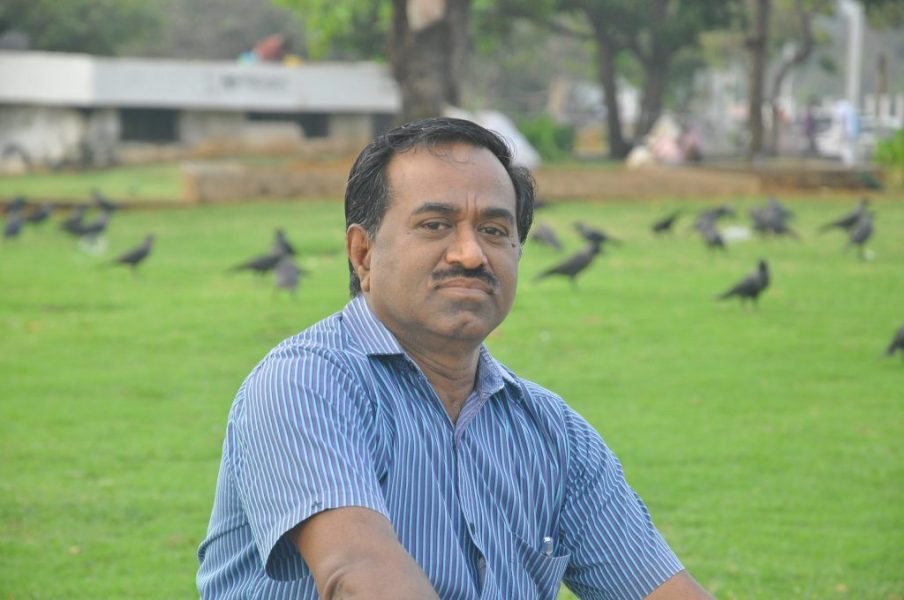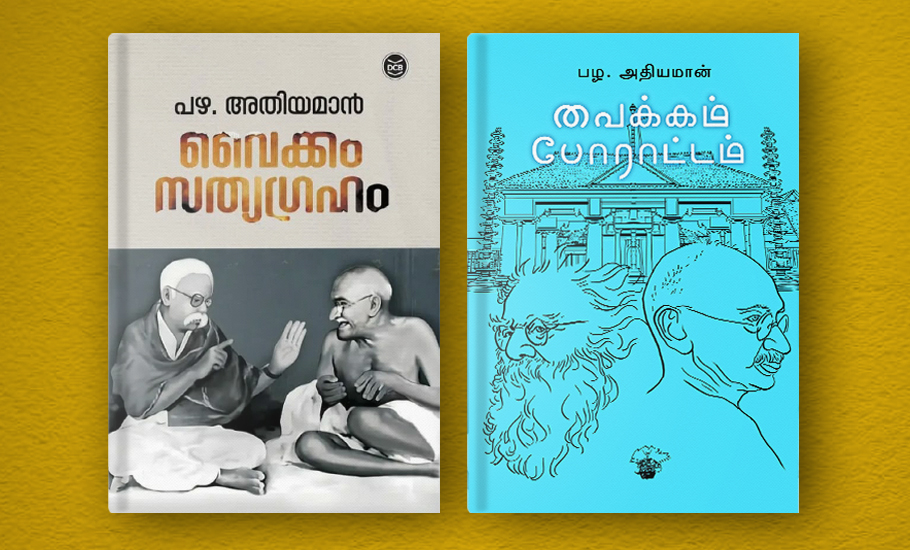
Pazha Athiyaman: ‘It’s surprising why Kerala didn’t focus on Gandhi’s role in Vaikom struggle’

Well-known Tamil writer Pazha Athiyaman has a reason to celebrate as his long-awaited moment of happiness has finally arrived. His book on the history of Vaikom Satyagraha (struggle) in Kerala, Vaikkom Porattam (Kalachuvadu Publications), which was released in 2020, is garnering the attention it deserves after three years — all thanks to the centenary celebrations commemorating what can be deemed as India’s first battle for the right to enter temples.
The year-long struggle — which kicked off on March 30, 1924 and ended on November 23, 1925 — united not only the inhabitants of present-day Tamil Nadu and Kerala but also individuals from as far as Punjab and Sri Lanka. The battle stands as a testament to the brotherhood fostered by the satyagrahis, who shedded their religion, language, gender, political ideology and cultural disparities in their pursuit of justice.
While numerous books have been published on this subject in Tamil, Malayalam, and English, they merely skimmed over the struggle with passing references. But this is the first book in any language that chronologically documents the day-to-day affairs of the satyagraha.
A work of scholarship
Running into more than 600 pages, with approximately 300 pages dedicated to providing a comprehensive context for the struggle, the sheer volume of official documents cited in this book is breathtaking. It is because of its scholarship that the Tamil Nadu government has got the book translated into Malayalam. With both state governments having decided to hold the year-long celebrations to commemorate the centenary of the struggle, the book is getting its due attention, from Tamil Nadu as well as Kerala.
Also read: Tamil writer Imayam on female desire and why writing is a political activity
“Just when the book was beginning to receive responses from various quarters in Tamil Nadu, the Covid-19 pandemic struck. Consequently, numerous functions planned in several parts of the state to release the book were cancelled. That could be one major reason why it didn’t get the attention it needed, Athiyaman tells The Federal.
“I didn’t receive any phone calls from Tamil readers for the book initially. However, once the book was translated into Malayalam and released on April 1 this year, I received around 10 to 15 calls from Malayalam readers,” he adds. The Federal managed to catch up with the writer for this interview even as he is immersed in a flurry of activities related to the centenary celebrations.
Before delving into the writer’s ongoing research into the struggle, which began in 2011 and continues to this day, let us look at the new insights the book offers.
‘Vaikom: A lab for satyagraha experiment’
At a time when prominent Tamil writers like Jeyamohan attempt to downplay the role of Tamil Nadu’s revered social reformer Periyar EV Ramasamy in this struggle, the book sheds light on a hitherto unknown fact. While the Vaikom struggle unfolded in Kerala and was predominantly carried forward by Malayalees, none of the Keralites were imprisoned twice.
It was Periyar, who went to jail for two terms, enduring imprisonment for a total of 74 days. He was treated not as a political prisoner, but rather like a murder convict, with his legs chained. He was also the only person to receive a continuous four-month prison sentence. Undeterred, Periyar shuttled between Kerala and Tamil Nadu for seven times, spending a cumulative total of 141 days in the region, including his time behind bars.

Secondly, one of the earliest leaders of the struggle, George Joseph (1887-1938), was asked by Mahatma Gandhi to refrain from getting involved as the struggle was primarily perceived as a Hindu issue. Joseph, instead, became the first person to recognize the significance of the struggle as a fight for fundamental civil rights, specifically the right of Dalits to access the temple road.
Thirdly, when the leaders from Kerala Congress were being arrested and they were unable to find suitable replacements, they dashed off a letter to Gandhi for assistance. However, the letters written by Gandhi reveal his reluctance to convert the Vaikom satyagraha into a national movement. Gandhi scoffed at the requests of Kerala leaders, asserting that the struggle would be handled by the Congress leaders in Tamil Nadu. This marked the moment when Periyar was brought into the scene.
Also read: Jeyamohan interview: Ezhaam Ulagam, or The Abyss, is a spiritual inquiry into beggars’ lives
Fourthly, Gandhi supported the struggle just to ensure that the Dalits should be allowed to use the temple road. Periyar, on the other hand, envisioned that the struggle would be completed only when the Dalits were permitted inside the temple. However, according to Athiyaman, Periyar considered the temple entry as secondary, and therefore, did not stress on it.
Fifthly, the book presents ample evidence to show how Gandhi made the struggle more and more difficult as the days passed on. At first, he narrowed its bandwidth by framing it as a struggle within the context of Hinduism. Then, he stopped the langar organised by Sikhs, who provided food for satyagrahis. Furthermore, he did not let the struggle turn into a national one. Also, he turned down the financial help offered by the Hindus abroad when the struggle was facing a severe cash crunch. Gandhi also didn’t like Congress interfering in provincial matters; one of the Congress’ principles was that it would not interfere in the matters of Indian Province governments.
“While there were differences among the satyagrahis at that time, today the struggle is regarded as a laboratory for satyagraha experiments by Gandhians and a laboratory for social justice by Periyarists,” Athiyaman writes in the preface of this book.
Such a long journey
Athiyaman, a former broadcaster at All India Radio, spent seven years in research before commencing writing in 2018; it culminated in the completion of the book in 2019. “During my official trips to Kerala, I would visit state archives in Calicut, Ernakulam, and Thiruvananthapuram. I even became a member for six months to access the invaluable resources available there. However, a significant portion of my research relied on the papers sourced from the Nehru Memorial Museum and Library in New Delhi,” he says.
In addition to relying on archival materials, Athiyaman went the extra mile by personally visiting the families of the satyagrahis involved in the Vaikom struggle. However, due to the potential delay it would cause in the book’s publication, he had to limit these physical meetings.
“I wrote four drafts of this book, yet it remained unfinished. Although I gained access to Congress papers and Princely papers from the Kerala archives, I was unable to access the British papers, which are located in London. If I had access to those papers, we might have uncovered even more new findings on how the British — who controlled the princely states through their residents and agents — perceived this struggle,” Athiyaman says.
Regarding the Malayalam translation of the book, Athiyaman acknowledges that it contains certain errors which he intends to rectify and update in future editions. “Many Malayalam readers who have read the book expressed their astonishment at the fresh perspective on Gandhi portrayed within its pages. They have read books about this struggle which were published earlier, but none of them has seen Gandhi from the angle I have portrayed in the book,” he says.
Also read: The arid, defiant world of International Booker-longlisted Tamil writer Perumal Murugan
“It’s surprising why Kerala didn’t focus on Gandhi despite having many historical resources. It’s not that Malayalees lack a sense of history. Because, if you look at the Princely papers (located in East Fort archives), they have materials dating as far back as 1700 and accounts for each and every day. Yet, the lack of emphasis on Gandhi’s role remains unfathomable,” he adds.
The author adds that the Dravidian leaders then did not like dailies such as Swadesamitran, which was run by Brahmins and supported Congress. “But it was from there that I collected a lot of evidence to show Periyar’s role in this struggle,” he says. Touching upon the issue of negating Periyar’s role in this struggle, Athiyaman says that the people from both states should give equal importance to the two leaders.
“Let’s not make them stand against each other. Also one should remember that nowhere during the struggle did Periyar make any negative comment on Gandhi’s activities. Similarly, the women’s participation was not documented fully. So, let’s say, this book is Part One. I will come out with a sequel in future. Maybe,” he signs off.


